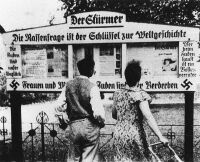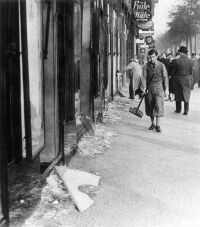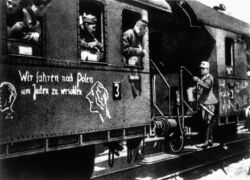





Propaganda board of the weekly newspaper Der Stürmer. The inscription on the left says: "Jews are our calamity".
Jews deported from the German Reich in the camp for the displaced persons in Zbąszyń, 1938. In this camp, established in October 1938, 17 thousand Jewish exiles of Polish origin found their refuge.
Soldiers of the allied German and Soviet armies discussing the course of the warfare in Poland, September 1939. The provisions of the Ribbentrop-Molotov Pact of the 23th August 1939 were fulfilled and confirmed by the treaty of frienship and boundaries of the 28th September 1939.
|

Jewish shops with broken windows. Repressions and persecutions against the Jews intensified after the so called "Night of Broken Glass" (9th/10th November 1938).
Jewish family fleeing before the German troops invading Poland, September 1939. It is estimated that after the 17th September about 300 thousand Jewish refugees found themselves in Kresy Wschodnie (Eastern Borderlands) of Poland, then seized by the Red Army.
Map of the Second Polish Republic with the German-Soviet demarcation line delineated at the end of September 1939. In the aftermath of that division about 2.1 million of the Jews found themselves under the German occupation.
|

Transporting of the German troops to the occupied Polish territories. The inscription on the carriage says: "We are going to Poland to dispose of the Jews", September 1939.
In 1920 in Germany there was established national socialist party (NSDAP), which made the hatred for the Jews one of the main points of its programme. After Hitler's coming to power in 1933, there began to be realized the plan of elimination of the Jewish population from the public sphere ("Nürnberg Laws" 1935, "Night of Broken Glass" 1938). The aggression of the Nazi Germany against Poland on the 1st September 1939 marked the beginning of the new stage, that, as the consecutive conquests took place, allowed to murder Jews from all over Europe. After September Campaign ending in defeat, Polish citizens, including the Jews, were subject to numerous restrictions introduced by the occupants. The Nürnberg Laws came into force in both the Polish territories annexed to the Reich and the General Government. The population of the defeated Poland hoped that the Germans would respect the international conventions. The Jews became the first victims of those illusions. The mass executions of the Poles and the Jews carried out by the Wehrmacht and Einsatzkommandos consisting of the army, police and SS units, revealed the new face of war.
Beginning of the Polish-German war. Wehrmacht soldiers break the border barrier in Sopot, 1st September 1939.
|

